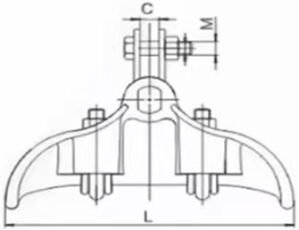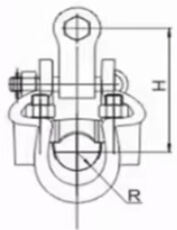1. Strong Grip
With special structural design and materials, it can firmly hold the conductor, ensuring that the conductor will not slip out of the clamp under various working conditions. It can withstand large conductor tension, providing reliable mechanical connection for power transmission lines.
2. Excellent Wear Resistance
The contact parts with the conductor are usually coated with wear-resistant layers or made of wear-resistant materials (such as self-lubricating alloys or ceramic composites). This design significantly reduces abrasion between the conductor and the clamp, prolonging the service life of both components and minimizing maintenance costs caused by wear.
3. Good Flexibility
The clamp body has a certain degree of flexibility, which can adapt to the expansion, contraction, and swinging of the conductor under different environmental conditions (e.g., temperature changes, wind vibrations). This flexible connection avoids conductor damage caused by rigid fixation, effectively preventing stress concentration and fatigue breakage.
4. Superior Corrosion Resistance
It undergoes anti-corrosion treatments such as hot-dip galvanizing, spray coating of anti-corrosion paint, or PTFE coating, forming a multi-layer protective barrier. This enables the clamp to resist external environmental erosion (e.g., salt fog, acid rain, industrial pollution) and maintain stable performance in harsh natural environments, with a designed service life of up to 50 years.
1. Enhanced Line Safety
With reliable conductor-gripping capability and superior performance, it effectively prevents conductor detachment, galloping, and other hazardous conditions, significantly improving the safety and stability of power line operation. This reduces the risk of power outages caused by mechanical failures and ensures continuous power supply.
2. Reduced Maintenance Costs
Thanks to its excellent wear and corrosion resistance, the need for maintenance and replacement due to clamp damage is minimized. This not only lowers the maintenance costs of the line but also reduces power outage time, improving the efficiency of power supply and minimizing economic losses caused by downtime.
3. Wide Application Range
Available in various specifications and models, it can adapt to different types and cross-sections of conductors, including aluminum-conductor steel-reinforced (ACSR) cables, aluminum stranded cables, etc. This versatility makes it suitable for diverse power transmission and distribution scenarios, from low-voltage distribution networks to high-voltage transmission lines.
This translation maintains technical accuracy in power engineering terminology (e.g., "aluminum-conductor steel-reinforced cables") and emphasizes practical benefits (e.g., "economic losses reduction"), making it suitable for technical proposals, product brochures, or international project presentations.
1. Conductor Suspension
Primarily used in overhead power lines to suspend conductors on utility poles or towers, maintaining specified heights and spacing between conductors. This ensures the normal operation o1. Conductor Suspension
Primarily used in overhead power lines to suspend conductors on utility poles or towers, maintaining specified heights and spacing between conductors. This ensures the normal operation of power lines by preventing electrical short-circuits and maintaining safe clearances.
2. Load Bearing
It bears the gravitational force of the conductor, wind load, ice/snow load, and other environmental loads, transmitting these forces to the poles or towers. Designed to withstand various meteorological conditions (e.g., strong winds, heavy icing), it ensures the safe suspension of conductors and the mechanical stability of the entire line system.
3. Conductor Protection
Through reasonable structural design and optimal contact surfaces, it reduces stress concentration at the suspension points, preventing conductor damage caused by mechanical fatigue or abrasion. This protective function significantly extends the service life of the conductor and minimizes the risk of breakage at critical connection points.f power lines by preventing electrical short-circuits and maintaining safe clearances.
2. Load Bearing
It bears the gravitational force of the conductor, wind load, ice/snow load, and other environmental loads, transmitting these forces to the poles or towers. Designed to withstand various meteorological conditions (e.g., strong winds, heavy icing), it ensures the safe suspension of conductors and the mechanical stability of the entire line system.
3. Conductor Protection
Through reasonable structural design and optimal contact surfaces, it reduces stress concentration at the suspension points, preventing conductor damage caused by mechanical fatigue or abrasion. This protective function significantly extends the service life of the conductor and minimizes the risk of breakage at critical connection points.


| Model | Conductor diameter range(Include EntangleMM) | SIZE(MM) | Maximum load capacity(KN) | Weight(KG) | ||||
| L | C | R | H | M | ||||
| XG-4022 | 13.2~22.0 | 210 | 20 | 11 | 120 | 16 | 40 | 1.75 |
| XG-4028 | 19.6~28.0 | 250 | 20 | 14 | 130 | 16 | 40 | 2.56 |
| XG-4034 | 27.4~34.0 | 300 | 20 | 17 | 130 | 16 | 40 | 3.35 |
| XG-6028 | 19.6~28.0 | 250 | 20 | 14 | 130 | 16 | 60 | 2.56 |
| XG-6034 | 27.4~34.0 | 300 | 20 | 17 | 130 | 16 | 60 | 3.35 |
| XG-6040 | 32.0~40.0 | 300 | 20 | 20 | 135 | 16 | 60 | 3.57 |
| XG-6046 | 36.8~46.0 | 330 | 20 | 23 | 135 | 16 | 60 | 3.95 |
| XG-8034 | 27.4~34.0 | 300 | 20 | 17 | 130 | 16 | 80 | 3.35 |
| XG-8040 | 32.0~40.0 | 300 | 20 | 20 | 140 | 16 | 80 | 3.95 |
| XG-8046 | 36.8-46.0 | 330 | 20 | 23 | 140 | 16 | 80 | 3.95 |
| XG-8054 | 43.2~54.0 | 345 | 20 | 27 | 150 | 16 | 80 | 4.8 |
| All measurements provided are manually obtained and may contain slight tolerances. Final dimensions shall be subject to the physical product. | ||||||||
Our professional sales team are waiting for your consultation.